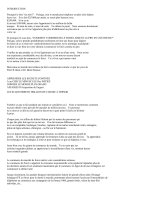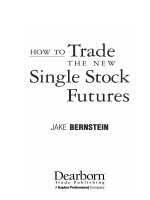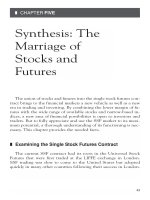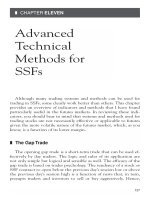The wyckoff methodology in depth how to trade financial markets
Bạn đang xem bản rút gọn của tài liệu. Xem và tải ngay bản đầy đủ của tài liệu tại đây (20.9 MB, 213 trang )
The Wyckoff Methodology in Depth
How to trade financial markets logically
Rubén Villahermosa
All rights reserved. No part of this work may be reproduced, incorporated
into a computer system or transmitted in any form or by any means
(electronic, mechanical, photocopying, recording or otherwise) without the
prior written permission of the copyright holders. Infringement of these rights
may constitute a crime against intellectual property.
Rubén Villahermosa, 2019
Independently published
ISBN: 9781703876123
Index of contents
Richard Wyckoff
Part 1 - How Markets Move
Chapter 1 - Waves
Chapter 2 - The price cycle
Chapter 3 - Trends
Types of trends
Chapter 4 - Assessing trends
Strength/weakness analysis
Speed
Projection
Depth
Lines
Horizontal lines
Trend lines
Channels
Inverted lines
Converging lines
Chapter 5 – Trading Ranges
Part 2 - The Wyckoff Method
Chapter 6 - Wyckoff Methodology Structures
Basic scheme of accumulation #1
Basic scheme of accumulation #2
Basic scheme of distribution #1
Basic scheme of distribution #2
Part 3 - The Three Fundamental Laws
Chapter 7 - The law of supply and demand
Theory
Price shift
Initiative
Lack of interest
Chapter 8 - The Law of Cause and Effect
Elements to bear in mind
Point and Figure Graphics
Technical analysis for projection of objectives
Chapter 9 - The Law of Effort and Result
The importance of volume
Harmony and divergence
In the development of a candle
On the next scroll
In the development of the movements
By Waves
By reaching key levels
Effort/Result in Trends
Lack of interest
Part 4 - The processes of accumulation and distribution
Chapter 10 - Accumulation
Stock control
The law of cause and effect
Handling maneuvers
Counterparty, liquidity
The path of least resistance
Common characteristics of the accumulation ranges
Beginning of the bullish movement
Chapter 11 - Reaccumulation
Stock Absorption
Duration of the structure
Reaccumulation or Distribution
Chapter 12 - Distribution
The law of cause and effect
Handling maneuvers
Counterparty, liquidity
The path of least resistance
Common characteristics of the distribution ranges
Beginning of the Bearish Movement
Chapter 13 - Redistribution
Redistribution or accumulation
Stock control
Duration of the structure
Part 5 - Events
Chapter 14 - Event #1: Preliminary Stop
How the preliminary stop appears on the graphic
The psychology behind the preliminary stop
Uses of the preliminary stop
Preliminary Support
Preliminary Supply
Chapter 15 - Event #2: Climax
Keys to climax
How the climax appears on the graph
The psychology behind the climax
Uses of Climax
Selling Climax
The Selling Climax of exhaustion
Buying Climax
The Buying Climax of exhaustion
Chapter 16 - Event #3: Reaction
The implications of its development
The anatomy of the reaction
Reaction Uses
Automatic Rally
Why the Automatic Rally takes place
Automatic Reaction
Why Automatic Reaction Occurs
Chapter 17 - Event #4: Test
Secondary Test
Functions of the Secondary Test
Secondary Test Features
The Secondary Tests of Phase B
Secondary Test on the upper end
Secondary Test on the lower end
The generic test
Where to look for tests
Test after shock
Test after breakout
Trend test
How the Test appears on the graph
_Toc35599175
The difference between the Secondary Test and the Generic Test
Chapter 18 - Event #5: Shaking
Addition game 0
Behavior
How the Spring appears on the graph
Shaking functions
Indications to know if we are facing a potential shakeout
Avoid labeling errors
Spring/Shakeout
Types of Spring
The Ordinary Shakeout
The Spring test
UpThrust After Distribution (UTAD)
The minor Upthrust After Distribution
The Upthrust After Distribution Test
Terminal Upthrust
Ordinary Upthrust
Chapter 19 - Event #6: Breakout
Change of Character
How it appears on the graph
The breakout without volume
Keys to the breakout event
Breakout does not offer an opportunity
Sign of Strength
Minor SOS
Sign Of Strength Bar
Sign of Weakness
minor SOW
Sign Of Weakness Bar
Chapter 20 - Event 7: Confirmation
How the confirmation appears on the graph
Warning signal after breakout
Operational Opportunity
Quantify the entry trigger
Last Point of Support
Last Point of Supply
Part 6 - Phases
Chapter 21 - Phase A: Stopping the previous trend
Chapter 22 - Phase B: Building the Cause
Chapter 23 - Phase C: Test
Chapter 24 - Phase D: Trend within range
Chapter 25 - Phase E: Trend out of range
Part 7 - Trading
1. The context
2. The structures
3. Operational areas
Chapter 26 - Primary positions
In Phase C
Entry into the shake
Entry into the shake test
Entry into the Last Point of Support
In Phase D
Entry into the trend movement within the range
Entry into the break test (Confirmation Event No. 7)
In Phase E
Summary table of trading opportunities
Chapter 27 - Decision-making
The concept of the significant bar
The concept of reversal of movement
Position Management
Calculate the size of the position
Entry
Stop Loss
Take Profit
Part 8 - Case Studies
S&P500 Index ($ES)
Pound/Dollar cross ($6B)
Euro/Dollar cross ($6E)
Bitcoin (BTCUSDT)
Inditex (ITX)
Google (GOOGL)
Australian Dollar/US Dollar cross ($6A)
Bibliography
Richard Wyckoff
Richard Wyckoff (1873-1934) became a Wall Street celebrity.
He was a forerunner in the investment world as he started as a stockbroker at
the age of 15 and by the age of 25 already owned his own brokerage firm.
The method he developed of technical analysis and speculation arose from
his observation and communication skills.
Working as a Broker, Wyckoff saw the game of the big operators and began
to observe through the tape and the graphics the manipulations they carried
out and with which they obtained high profits.
He stated that it was possible to judge the future course of the market by its
own actions since the price action reflects the plans and purposes of those
who dominated it.
Wyckoff carried out its investment methods achieving a high return. As time
passed his altruism grew until he redirected his attention and passion to
education.
He wrote several books as well as the publication of a popular magazine of
the time "Magazine of Wall Street".
He felt compelled to compile the ideas he had gathered during his 40 years of
Wall Street experience and bring them to the attention of the general public. I
wanted to offer a set of principles and procedures about what it takes to win
on Wall Street.
These rules were embodied in the 1931 course "The Richard D. Wyckoff
Method of Trading and Investing Stocks. A course of Instruction in Stock
Market Science and Technique" becoming the well known Wyckoff method.
Part 1 - How Markets Move
Chapter 1 - Waves
Wyckoff and the first readers of the tape understood that the movements of
the price do not develop in periods of time of equal duration, but that they do
it in waves of different sizes, for this reason they studied the relation between
the upward and downward waves.
The price does not move between two points in a straight line; it does so in a
wave pattern. At first glance they seem to be random movements, but this is
not the case at all. The price is shifted up and down by fluctuations.
Waves have a fractal nature and interrelate with each other; lower grade
waves are part of intermediate grade waves, and these in turn are part of
higher grade waves.
Each uptrend and downtrend is made up of numerous minor uptrend and
downtrend waves. When one wave ends, another wave starts in the opposite
direction. By studying and comparing the relationship between waves; their
duration, velocity and range, we will be able to determine the nature of the
trend.
Wave analysis provides a clear picture of the relative changes between supply
and demand and helps us judge the relative strength or weakness of buyers
and sellers as price movement progresses.
Through judicious wave analysis, the ability to determine the end of waves in
one direction and the beginning in the opposite direction will gradually
develop.
Chapter 2 - The price cycle
In the basic structure of the market there are only two types of training:
▶ Trends. These can be bullish if they go up, or bearish if they go down.
▶ Trading ranges. They can be of accumulation if they are at the beginning
of the cycle, or of distribution if they are in the high part of the cycle.
As we have already seen, the displacement of the price during these Phases is
done by means of waves.
During the accumulation phase, professional operators buy all the stock that
is available for sale on the market. When they are assured by various
manoeuvres that there is no longer any floating bid, they begin the upward
trend phase. This trend Phase is about the path of least resistance.
Professionals have already verified that they will not encounter too much
resistance (supply) that would prevent the price from reaching higher levels.
This concept is very important because until they prove that the road is free
(absence of sellers), they will not initiate the upward movement; they will
carry out test maneuvers again and again. In case the offer is overwhelming,
the path of least resistance will be down and the price at that point can only
fall.
During the uptrend, buyers' demand is more aggressive than sellers' supply.
At this stage there is the participation of large operators who are less well
informed and the general public whose demand shifts the price upwards. The
movement will continue until buyers and sellers consider the price to have
reached an interesting level; buyers will see it as valuable to close their
positions; and sellers will see it as valuable to start taking short positions.
The market has entered the distribution phase. A market ceiling will be
formed and it is said that the big operators are finishing distributing (selling)
the stock they previously bought. There is the entry of the last greedy buyers
as well as the entry for sale of well-informed operators.
When they find that the path of least resistance is now down, they begin the
downtrend phase. If they see that demand is present and with no intention of
giving up, this resistance to lower prices will only leave a viable path:
upward. If you continue to climb after a pause, this structure will be
identified as a reaccumulation phase. The same is true for the bearish case: if
the price comes in a bearish trend and there is a pause before continuing the
fall, that lateral movement will be identified as a redistribution phase.
During the downtrend sellers' supply is more aggressive than buyers' demand
so only lower prices can be expected.
Being able to determine at what stage of the price cycle the market is at is a
significant advantage. Knowing the general context helps us avoid entering
the wrong side of the market. This means that if the market is in a bullish
phase after accumulation we will avoid trading short and if it is in a bearish
phase after distribution we will avoid trading long. You may not know how
to take advantage of the trend movement; but with this premise in mind, you
will surely avoid having a loss by not attempting to trade against the trend.
When the price is in phases of accumulation or uptrend it is said to be in a
buying position, and when it is in Phases of distribution or downtrend it is
said to be in a selling position. When there is no interest, that no campaign
has been carried out, it is said to be in neutral position.
A cycle is considered to be complete when all stages of the cycle are
observed: accumulation, uptrend, distribution, and downtrend. These
complete cycles occur in all temporalities. This is why it is important to take
into account all the time frames; because each of them can be at different
stages. It is necessary to contextualize the market from this point of view in
order to carry out a correct analysis of it.
Once you learn to correctly identify the four price phases and assume a
totally impartial viewpoint, away from news, rumors, opinions and your own
prejudices, taking advantage of your operative will be relatively easier.
Chapter 3 - Trends
Prices change and the waves resulting from those price changes generate
trends. The price is moved by a series of waves in the direction of the trend
(impulses), which are separated by a series of waves in the opposite direction
(reversals).
The
trend is simply the line of least resistance as the price moves from one point
to another because it follows the path of least resistance; therefore, the
trader's job is to identify the trend and trade in harmony with it.
When a market is rising and encounters resistance (sales), either exceeds that
resistance or the price will turn; the same happens when the price is falling
and encounters resistance; either exceeds those purchases or the price will
turn. These pivot points are critical moments and provide excellent locations
to operate.
Depending on the direction of movement, we can differentiate three types of
trends: bullish, bearish and lateral. The most objective description of an
uptrend is when the price makes a series of rising impulses and falls, where
highs and lows are increasing all the time. Similarly, we identify a bearish
trend when highs and lows are decreasing, leaving a series of decreasing
impulses and regressions. Finally, we determine a sideways environment
when highs and lows remain fluctuating within a price range.
Trends are divided by their duration into three different categories; long,
medium and short term. Since there are no strict rules for classifying them
according to the timeframe, they can be categorized according to how they fit
into the top. That is, the short term trend will be observed within the medium
term trend, which in turn will be within the long term trend.
Types of trends
Note that all three trends may not move in the same direction. This can
present potential problems for the operator. In order to be effective, doubts
must be eliminated as much as possible and the way to do this is to identify in
advance the type of trading to be carried out.
A very important condition to take into account when selecting the type of
trading is the Timing (entry calibration). Success in any kind of operative
mainly requires a good Timing; but success in short term trading requires a
perfect Timing. Because of this, a beginner should start with long-term
trading until he achieves consistent success.
Because trends may be different depending on the time frame, it is possible
but difficult to have buy and sell positions at the same time. If the mediumterm trend is bullish, you can take a buy position with the expectation of
holding it for a few weeks or months; and if in the meantime a short term
bearish trend appears, you can take a short sell position and hold the buy
trade
at
the
same
time.
Although theoretically possible, it is extremely difficult to maintain the
discipline necessary to maintain both positions at the same time. Only
experienced operators should do this. For the initiate it is best to operate in
harmony with the trend and not to operate on both sides simultaneously until
consistently profitable.
You must learn and understand the motives, behavior patterns, and emotions
that control the market. A bull market is driven by greed, while a bear market
is driven by fear. These are the main emotions that drive the markets. Greed
leads to paying higher prices until it leads to what is known as an overbought
condition. On the other hand, the panic caused by falls leads to wanting to get
rid of positions and sell, adding more momentum to the collapse until overselling conditions are reached.
Having these emotions is not a negative thing, as long as they know how to
move towards a positive aspect and it is very clear that what is really
important is the protection of capital.
Chapter 4 - Assessing trends
This interaction between supply and demand as a trend develops will leave
clues in the conformation of the price action. We have different tools to help
us assess trends.
Judiciously assessing the trend is key to determining your health. It allows us
to detect if any force gives symptoms of weakness or if the opposing force is
gaining strength. Our job is to go for strength and against weakness.
Strength/weakness analysis
When the price is in trend, we expect greater strength from the pushing side.
We have to see it as a battle between buyers and sellers where we will try to
analyze the strength or weakness of both. The best way to assess current
strength/weakness is to compare it with previously developed movements.
A weakness in the price does not imply a change of trend, it is simply a sign
of loss of strength and tells us that we must be prepared for future
movements.
There are several ways to analyze market strength/weakness. The key is
comparison. Absolute values are not sought. It is a question of comparing the
current movements with the previous ones.
Speed
Speed refers to the angle at which the price moves; so if the price is moving
faster than in the past, there is strength. If on the other hand it is moving
slower than in the past, it suggests weakness.
Projection
With this tool we evaluate the distance that the impulses travel and compare
them with the previous ones to determine if the strength has increased or
decreased.
For a trend to remain alive, each impulse must surpass the previous impulse.
If an impulse is not able to make new progress in the direction of the trend, it
is an alert that the movement may be nearing its end.
Distance of the impulse:
The distance between 3 and 4 is greater than the distance between
1 and 2 = trend strength.
The distance between 5 and 6 is less than the distance between 3
and 4 = trend weakness.
Distance between extremes:
The distance between 2 and 3 is greather than the distance
between 1 and 2 = trend strength.
The distance between 3 and 4 is less than the distance between 2
and 3 = trend weakness.
Depth
With depth analysis we evaluate the distance travelled by trend reversals to
determine whether weakness has increased or decreased.
As
with projection analysis, we can evaluate depth using two measurements: the
total distance of the recoil from its origin to its end; and the distance the price
travels from the previous end to the new end.
Pullback distance:
The distance between 3 and 4 is less than the distance between 1
and 2 = trend strength.
The distance between 5 and 6 is greater than the distance between
3 and 4 = trend weakness.
Distance between extremes:
The distance between 2 and 3 is less than the distance between 1
and 2 = trend weakness.
The distance between 3 and 4 is greater than the distance between
2 and 3 = trend strength.
Lines
The lines delimit the ranges and define the angle of advance of a trend. They
are of great visual aid for the analyses, being very useful to evaluate the
health of the movement; so much to identify when the price reaches a
condition of exhaustion, as to value a possible turn in the market.
In general they help us to foresee levels of support and resistance at which to
wait for the price. At the same time, an approach or touch of those lines
suggests the search for additional signs to look for a turn, offering diverse
operative opportunities.
The more touches a line has, the more validity the level for the analysis will
have. You must be careful not to draw lines indiscriminately, especially on
every minor movement. The correct handling of lines requires good
judgment; otherwise it will cause confusion in your reasoning.
When the price penetrates a line we must remain more alert and be prepared
to act. Depending on the position where the break occurs, as well as the
action itself, we can suggest different scenarios. A thorough understanding of
price and volume action is needed to determine the most likely scenarios.
Horizontal lines
A horizontal line identifies an old zone of imbalance between supply and
demand. When it connects at least two price minima it identifies a support.
This is an area where buyers appeared in the past to outdo sellers and stop the
price drop. On that area it is expected that buyers will appear again when it is
visited again.
A
horizontal line connecting at least two highs identifies a resistance and is an
area where supply outpaced demand by stopping a price hike; that is why
sellers are expected to reappear on a new visit in the future.
When a line serves both as support and resistance, it is known as a shaft line.
Prices tend to revolve around those axis lines. Those price levels are
constantly changing roles; a broken resistor becomes a support, and a broken
support becomes a resistor.
Trend lines
After identifying the nature of the trend, the next step is to build a guideline
in order to take advantage of the movement. It is the simple connection
between two or more price points.
In a bearish trend, the trend line is drawn by connecting two decreasing
highs. This line is called the bid line because it is assumed that the sellers will
appear on it.
In an uptrend, the trendline is drawn by connecting two rising lows. This line
is called a demand line because it marks the point where buyers are supposed
to appear.
We can continuously readjust the trend lines in order to adjust the one that
best suits the price action and therefore generated the most touches. The more
times the line has been respected, the stronger we will be able to interpret it
when it is played again in the future.
Note that a line with too much slope will be broken too soon, so it will not be
drawn correctly.
As long as the price remains within the established levels, it is said that the
movement is healthy and it is appropriate to consider maintaining or adding
positions.









